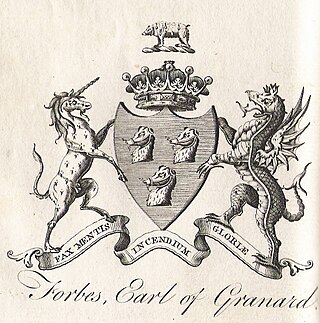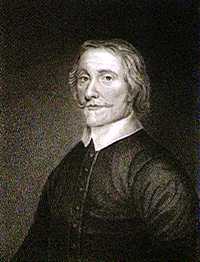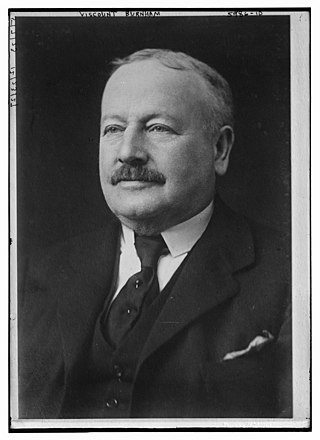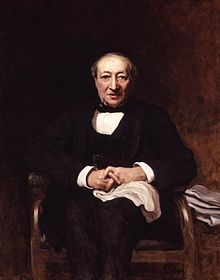
Viscount Cobham is a title in the Peerage of Great Britain that was created in 1718. Owing to its special remainder, the title has passed through several families. Since 1889, it has been held by members of the Lyttelton family.

Earl Ferrers is a title in the Peerage of Great Britain. It was created in 1711 for Robert Shirley, 14th Baron Ferrers of Chartley. The Shirley family descends from George Shirley of Astwell Castle, Northamptonshire. In 1611 he was created a Baronet, of Staunton Harold in the County of Leicester, in the Baronetage of England. He was succeeded by his son Henry, the second Baronet, who married Lady Dorothy Devereux, daughter of Robert Devereux, 2nd Earl of Essex. On the death of her brother Robert Devereux, 3rd Earl of Essex, she became the youngest co-heir to the baronies of Ferrers of Chartley and the barony of Bourchier, which had fallen into abeyance on the death of the third Earl. Shirley was succeeded by his eldest son, the third Baronet. He died unmarried and was succeeded by his younger brother, the fourth Baronet. He was imprisoned in the Tower of London by Oliver Cromwell and died there in 1656. On his death the title passed to his eldest son, the fifth Baronet. He died at an early age and was succeeded at birth by his posthumous son, the sixth Baronet.

Earl Waldegrave is a title in the Peerage of Great Britain. It was created in 1729 for James Waldegrave, 2nd Baron Waldegrave.

Baron Stafford, referring to the town of Stafford, is a title that has been created several times in the Peerage of England. In the 14th century, the barons of the first creation were made earls. Those of the fifth creation, in the 17th century, became first viscounts and then earls. Since 1913, the title has been held by the Fitzherbert family.

Earl of Granard is a title in the Peerage of Ireland. It was created in 1684 for Arthur Forbes, 1st Viscount Granard. He was a lieutenant-general in the army and served as Marshal of the Army in Ireland after the Restoration and was later Lord Justice of Ireland. He had already succeeded his father as second Baronet of Castle Forbes and been created Baron Clanehugh and Viscount Granard in 1675, also in the Peerage of Ireland. The baronetcy, of Castle Forbes in county Longford, was created in the Baronetage of Nova Scotia on 29 September 1628 for his father, Arthur Forbes.

Earl of Kingston is a title in the Peerage of Ireland. It was created in 1768 for Edward King, 1st Viscount Kingston. The Earl holds the subsidiary titles Baron Kingston, of Rockingham in the County of Roscommon, Viscount Kingston, of Kingsborough in the County of Sligo, Baron Erris, of Boyle in the County of Roscommon, and Viscount Lorton, of Boyle in the County of Roscommon, also in the Peerage of Ireland. He is also a baronet in the Baronetage of Ireland. Between 1821 and 1869 the earls also held the title Baron Kingston, of Mitchelstown in the County of Cork, in the Peerage of the United Kingdom.

Earl of Lonsdale is a title that has been created twice in British history, firstly in the Peerage of Great Britain in 1784, and then in the Peerage of the United Kingdom in 1807, both times for members of the Lowther family.

Viscount Valentia is a title in the Peerage of Ireland. It has been created twice. The first creation came in 1621 for Henry Power. A year later, his kinsman Sir Francis Annesley, 1st Baronet, was given a "reversionary grant" of the viscountcy, which stated that on Power's death Annesley would be created Viscount Valentia. Annesley, a member of an influential Anglo-Irish family which descended from Newport Pagnell in the County of Buckinghamshire, was a favourite of James I, who granted him land in Ireland, notably the fort of Mountnorris in County Armagh. He was knighted in 1616, created a baronet, of Newport Pagnell in the County of Buckingham, in the Baronetage of Ireland in 1620 and Baron Mountnorris, of Mountnorris in the County of Armagh, in 1628.
Viscount Camrose, of Hackwood Park in the County of Hampshire, is a title in the Peerage of the United Kingdom. It was created on 20 January 1941 for the prominent newspaper magnate William Berry, 1st Baron Camrose. He had previously received the award of Baronet, of Long Cross in the County of Surrey, in the Baronetage of the United Kingdom, on 4 July 1921, and was created Baron Camrose, of Long Cross in the County of Surrey, on 19 June 1929, in the Peerage of the United Kingdom. His second son, the third Viscount, disclaimed the peerages in 1995 on succeeding his elder brother. However, he had already been created a life peer as Baron Hartwell, of Peterborough Court in the City of London, on 19 January 1968. On his death in 2001 the life peerage became extinct while he was succeeded in the other titles by his eldest son, the fourth Viscount. The first three Viscounts all headed The Daily Telegraph at one point, the first having purchased it from Harry Levy-Lawson, 1st Viscount Burnham, but in the 1980s they lost control to Conrad Black.

Viscount St Davids, of Lydstep Haven in the County of Pembroke, is a title in the Peerage of the United Kingdom. It was created in 1918 for John Philipps, 1st Baron St Davids. The Philipps family descends from Sir John Philipps, who represented Pembrokeshire in the House of Commons. In 1621 he was created a Baronet, of Picton Castle in the County of Pembroke, in the Baronetage of England. His grandson, the third Baronet, also sat as Member of Parliament for Pembrokeshire. He was succeeded by his son, the fourth Baronet. He represented Pembroke and Haverfordwest in Parliament. His son, the fifth Baronet, sat for Haverfordwest. He was succeeded by his younger brother, the sixth Baronet. He represented Carmarthen, Petersfield and Pembrokeshire in the House of Commons.
Baron Crofton is a title in the Peerage of Ireland. It was created in 1797 for Dame Anne Crofton. She was the widow of Sir Edward Crofton, 2nd Baronet, of the Mote, who had represented Roscommon in the Irish House of Commons and had been offered a peerage just before his death. The peerage was instead bestowed upon his widow. She was succeeded by her grandson, the second Baron, who had already succeeded as fourth Baronet. He sat in the House of Lords as an Irish Representative Peer from 1840 to 1869 and served as a Lord-in-waiting in the three Conservative administrations of the Earl of Derby and in Benjamin Disraeli's first government. His son, the third Baron, served as an Irish Representative Peer between 1873 and 1912 and was also State Steward to the Lord Lieutenant of Ireland. His nephew, the fourth Baron, was an Irish Representative Peer from 1916 to 1942. As of 2014 the titles are held by the latter's great-great-grandson, the eighth Baron, who succeeded his father in 2007.

Baron Milford is a title that has been created three times, once in the Peerage of Ireland and twice in the Peerage of the United Kingdom. All three creations have been for members of the same family. The first creation came in the Peerage of Ireland in 1776 when Sir Richard Philipps, 7th Baronet, of Picton Castle was made Baron Milford. However, this title became extinct on his death in 1823, while the baronetcy was passed on to a distant relative. The title was revived in the Peerage of the United Kingdom in 1847 when Sir Richard Philipps, 1st Baronet, of Picton Castle was created Baron Milford, of Picton Castle in the County of Pembroke. Born Richard Bulkeley Philipps Grant, he was the son of John Grant and Mary Philippa Artemisia, daughter of James Child and Mary Philippa Artemisia, daughter of Bulkeley Philipps, uncle of the first Baron of the first creation. He succeeded to the Philipps estates in 1823 and assumed the surname of Philipps the same year. In 1828 he was created a Baronet, of Picton Castle in the County of Pembroke, in the Baronetage of the United Kingdom. However, Lord Milford was childless and the titles became extinct on his death in 1857. He devised his estates to his half-brother Reverend James Henry Alexander Gwyther, who assumed the surname of Philipps. James's daughter Mary Philippa married Charles Edward Gregg Fisher, who assumed the surname of Philipps and was created a Baronet, of Picton, in 1887.

Baron Dufferin and Claneboye, of Ballyleidy and Killyleagh in County Down, Northern Ireland, is a title in the Peerage of Ireland. It was created on 30 July 1800 for Dame Dorcas Blackwood, widow of Sir John Blackwood, 2nd Baronet, Member of the Irish Parliament for Killyleagh and Bangor, in return for support for the Union of Ireland and the United Kingdom.

William Ewart Berry, 1st Viscount Camrose, DL was a British peer and newspaper publisher.

Baron Tredegar, of Tredegar in the County of Monmouth, was a title in the Peerage of the United Kingdom. It was created on 16 April 1859 for the Welsh politician Sir Charles Morgan, 3rd Baronet, who had earlier represented Brecon in Parliament. His eldest son, Charles Rodney Morgan, sat as Member of Parliament for Brecon, but predeceased his father. Lord Tredegar was therefore succeeded by his second son, the second Baron.

Edward Levy-Lawson, 1st Baron Burnham,, known as Sir Edward Levy-Lawson, 1st Baronet, from 1892 to 1903, was an English newspaper proprietor. He was the owner and publisher of The Daily Telegraph.

Harry Lawson Webster Levy-Lawson, 1st Viscount Burnham,, was a British newspaper proprietor. He was originally a Liberal politician before joining the Liberal Unionist Party in the late 1890s. He sat in the House of Commons 1885–1892, 1893–1895, 1905–1906 and 1910–1916 until he inherited the Burnham barony on the death of his father.

Major-General Edward Frederick Lawson, 4th Baron Burnham, CB, DSO, MC, TD, was a British newspaper executive and Territorial Army officer who served with distinction in both World Wars.

Earl of Arran is a title in the Peerage of Ireland. It is not to be confused with the title Earl of Arran in the Peerage of Scotland. The two titles refer to different places: the Aran Islands in Ireland, and the Isle of Arran in Scotland. The Irish earldom is held by the Gore family. The Scottish earldom is a separate title, held as a subsidiary title of the Duke of Hamilton.














